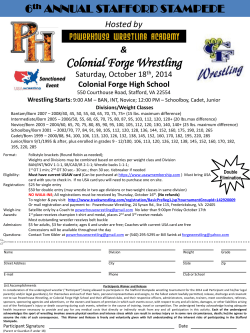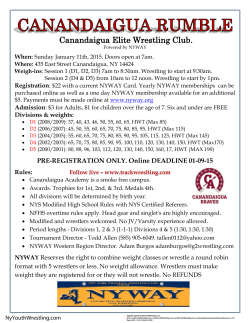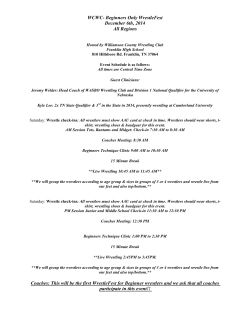
Document 158466
74602 p32p33.qxp 20/5/09 16:04 Page 1 THE BLADE Power Slam has never before acknowledged the existence of blading in pro wrestling. We’ve hinted at it many times, but never come out and written: wrestlers deliberately cut themselves with slivers of razor blades in matches. Glad we’ve got that over with, finally. In this, the first of a twopart series on blading, FIN MARTIN explains how he discovered the practice as a fan — and when and why it was introduced to pro wrestling . . . BACK IN THE LATE 1980S, years before I same thing the next night in another town? entered the wrestling magazine business as But while I recognised wrestling was a work editor of Power Slam’s forerunner Superstars (a term I would learn years later), there was Of Wrestling (a title launched in early 1992), I one aspect of it that baffled me. It was the would pore over as much U.S., Japanese and blood I would see sporadically in matches, British wrestling as I could. There were two and in lurid magazine photographs of Dusty reasons for this: I enjoyed the spectacle of it Rhodes, Abdullah The Butcher, Ric Flair, The all. And I was determined to work out how Sheik, Bruiser Brody, Tommy Rich and others. they did what they did in the ring. Friends and relatives — who knew far less Bear in mind, this was pre-internet. I had about wrestling than me — would pompously never read a newsletter, nor seen ABC’s assure me the blood in wrestling was fake. But notorious 20/20 exposé (broadcast in none, when quizzed, could explain where the February 1985 in which wrestler Eddie wrestlers would conceal this “fake blood” at Mansfield revealed the secrets of pro wrestling the beginning of their bouts, how they could to reporter John Stossel), and had yet to meet apply it to their foreheads undetected by the any other fans who knew the inner workings audience while a contest was in progress, and of the business. Even wrestling magazines then ensure the blood continued to flow for were hard to come by two decades ago — several minutes or more. Wrestlers in matches, at least in my hometown of Kendal, Cumbria held before spectators, couldn’t use tubes, — and those that were available pretended blood bags or other special make-up effects wrestling was an authentic sporting contest. like they do in films. Like most people, I knew pro wrestling was Armed with this evidence, and photos of nothing of the sort. It clearly couldn’t be. scarring on foreheads of wrestlers like Wrestlers would break their hands and bruise Abdullah and Brody, I came to the conclusion opponents’ faces and bodies and knock teeth that the blood in wrestling had to be real. out if they really punched each other I was right. repeatedly with bare fists. Former NWA World champion Tommy Rich, I realised they had to be a habitual bleeder in the cooperating with each other to 1980s, was the pro wrestler A blade. (No execute the often spectacular who alerted me to the practice prizes for guessing who’s holding it.) moves they did as smoothly as of what is known in the business they did (in many cases) without as “blading”. breaking each other’s necks. It was during an angle for The whole thing had to be a the fading WWA promotion in carefully orchestrated Ohio/Michigan in the late performance in which wrestlers 1980s, which made its way feigned pain and injury. How onto a videotape called else could they beat each other Wrestling’s Bloodiest Battles in senseless, and then do the 1990. Rich, while being choked 32 with a chain, reached up to his forehead and, suddenly, blood started running down it. This was startling to me: neither the chain nor his opponent’s fists had made contact with Rich’s forehead and, yet, he had been cut. How was this possible? Simple: Rich had cut himself (to this day, I can’t explain why he did so in that situation: it was a total exposé of the business, obviously). Like that, my eyes were open. I went back and watched the handful of bloody matches I had on videotape to see if the juice had started flowing after the affected wrestler had dug something into his own forehead. Sure enough, King Kong Bundy sliced himself in his Cage match with Hulk Hogan at WrestleMania II after he had been hurled headfirst into the blue-barred fence (Bundy then stashed the blade in his tights). Eric Embry, Ric Flair, Dusty Rhodes, Hogan: they all clearly did it in their matches. I could hardly believe I hadn’t spotted it before . . . BLADING — OTHERWISE KNOWN as gigging, juicing or getting colour — has been a part of the fabric of pro wrestling for at least 70 years. Enterprising wrestlers and promoters recognised that when blood was drawn in matches from a clash of heads or an accidental stiff shot to the nose, lip or eye that it would intensify the drama and crowd heat, Terry Funk digs his fingers into Dusty Rhodes’ bloody arm in a Barbed Wire match, Florida, early 1980s. especially when the talent worked the blood loss into the story of the match (yes, spontaneity in wrestling bouts was both permitted and encouraged in those days). Wrestlers and promoters also felt the presence of blood in matches legitimised the game: at a time when “protecting the business” was paramount, it served a dual purpose. Rather than potato punching each other to spill the blood, the concept of blading was implemented. To ensure the wrestler who had been booked or volunteered to bleed was in control of how long or deep the cut would be, it was decided the grappler should cut himself, rather than entrust the task to an opponent. (There have been many exceptions to this rule, by the way: In fact, referee Earl Hebner bladed Sting in his match with Mick Foley at Lockdown 2009; Ric Flair bladed Bill Goldberg in an Elimination Chamber beat-down at SummerSlam 2003; and manager Harley Race
© Copyright 2025





















